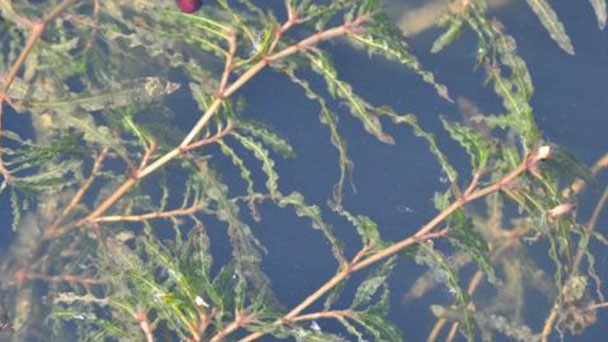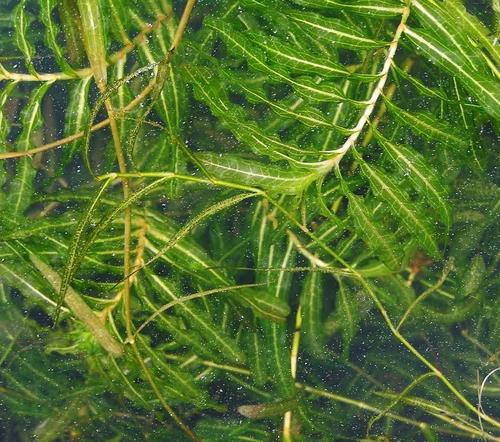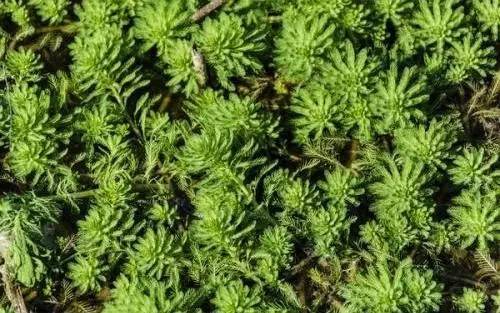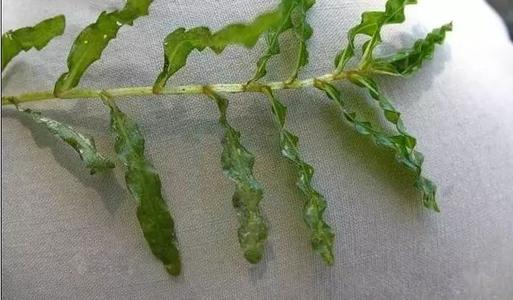Potamogeton crispus (Curly Pondweed) profile
Written by Maggie
Mar 25 2021

Potamogeton Crispus, commonly called curled pondweed or curly-leaf pondweed, is a perennial submerged aquatic grass plant. Potamogeton Crispus was born in ponds, lakes, streams, still water ponds or ditches more, the water is slightly acidic to neutral. Stem is oblate, with branching.
Potamogeton Crispus picture

Morphological characteristics of Potamogeton Crispus
Branch
Potamogeton Crispus is a perennial submerged plant with nearly cylindrical rhizomes. Stem is slightly flat, much branched, near the base often creeping ground, at the node to give birth to sparse or slightly dense fibrous roots.
Leaf
Leaves of Potamogeton crispus are sessile, 3 -- 8 cm long and 3 -- 10 mm wide, obtuse at apex, ca. 1 mm at base, connate with stipule, but not forming sheaths, margin more or less shallowly undulate, sparsely or slightly densely serrate; Potamogeton Crispus has 3-5 veins, parallel, apically connected, midvein with fine lines of aerated tissue on both sides near the base, secondary veins sparse and visible; Stipules are membranous, 5-10 mm long, caducous; Sleeping buds are axillary, slightly cone-like, 1-3 cm long, leathery leaves close to left and right, base expanded, hypertrophic, hard, margin serrate.
Flowers
Potamogeton crispus is a terminal spike with 2-4 flowers, at first 2 flowers in each round opposite, the cob elongated often slightly asymmetrical; Inflorescence peduncle is clavate, thinner than stem; Flowers are small, membranous 4, pale green, pistil 4, base connate.
Fruit
The fruit of Potamogeton Crispus is ovate, ca. 3.5 mm long, with a beak up to 2 mm long, slightly curved backward, and dentate to about 1/2 of the dorsal ridge.
Ecological habits of Potamogeton Crispus
Potamogeton Crispus is found in ponds, ditches, rice paddies, irrigation ditches and slow-flowing rivers that are slightly acidic to neutral.
Cultivation of Potamogeton Crispus
Potamogeton Crispus is mostly cultivated with stone buds, which can provide adequate nutrition and protection with high survival rate. Or root replacement cuttage culture, sediment, water quality of nutrients should be sufficient, Potamogeton Crispus seedlings should not be exposed to strong light, timely increase the water level, to cover the growth height of Potamogeton Crispus.
The Potamogeton Crispus region
Potamogeton Crispus is produced in the provinces and regions in the north and south of China, and is widely distributed in the world.
Application of Potamogeton Crispus
The economic value
Potamogeton Crispus is a good afforestation material in lakes, ponds and small waterscape for garden use. Potamogeton Crispus is a good natural feed for herbivorous fish. In some areas of our country, it is selected to store rice fields and raise fish. It can also be used as green manure.
The young stems and leaves can be eaten as vegetables.
Economic value of aquaculture
Potamogeton Crispus can substitute 5% wheat bran for fattening pigs and has no effect on growth performance of pigs. Potamogeton Crispus had obvious effects on increasing milk yield and fat percentage of dairy cattle, egg production rate, hatching rate and fertilization rate of breeding eggs of poultry. Potamogeton Crispus can be directly fed to fish. It is a green feed for grass carp, blunt bream, roach and so on. Potamogeton Crispus can also indirectly feed bait fish. The vegetative plants of Potamogeton Crispus are easy to rot in summer when fish grow fast, which can provide a lot of organic matter and nutritive salts for water, and promote the proliferation of planktonic bait resources. At the same time, in lakes, reservoirs and other fishery ecosystems, Potamogeton Crispus communities are also habitat and breeding places for mussels, snails, midges, aquatic earthworms and other organisms, which is conducive to the proliferation of economic fish feed resources such as carp, crucian carp, black carp, and promote their growth and development, and improve their yield.
Potamogeton Crispus can promote the safe wintering of fish. It grows normally in water under ice in winter. Oxygen produced by its photosynthesis is an important source of dissolved oxygen in water, which provides a guarantee for the safe wintering of fish in water. Potamogeton Crispus is beneficial to the protection and proliferation of economic fish. Its stems and leaves are the attachment of sticky eggs such as carp, crucian carp and Megalobrama amblycephala, and the tups of Potamogeton Crispus are the natural breeding places for them. At the same time, the larvae of economic fishes living in the Potamogeton Crispus bush are not vulnerable to the harm of the fierce fish, which is beneficial to the conservation and proliferation of the main economic fish resources.
Environmental value
Potamogeton Crispus had high zinc enrichment ability, and the zinc content in the body was more than 8 times of the original zinc content after being cultivated with the mixed wastewater containing zinc for about one month. Potamogeton Crispus has a better ability to purify arsenic. The natural arsenic content of Potamogeton Crispus is around 6ppm. However, the arsenic content in Potamogeton Crispus can exceed 16 times of the original arsenic content when it is grown in a mixed wastewater containing dipotassium hydrogen arsenate, zinc sulfate, mercury chloride and potassium dichromate at 2ppm each.
Nutritional value
Potamogeton Crispus samples from different producing areas showed significant differences in the measured values of conventional nutrients, which was largely related to the differences of producing areas, growing environment and growing period. However, the contents of crude protein, calcium and phosphorus were all above 100 g /kg, and the contents of crude ash in hay were all above 100 g /kg, indicating that Potamogeton Crispus powder was a good source of protein and mineral elements. Some vitamin contents in Potamogeton Crispus stem samples were: VB1 1. 8 mg /kg, VB2 7. 0 mg /kg, VB12 42 mg /kg, Vc 281 mg /kg and carotene 550 mg /kg. Potamogeton Crispus is rich in B vitamins. The content of carotene is higher than that of corn, wheat bran and green duckweed, so it is a good vitamin supplement.

Hazards and management of Potamogeton Crispus
Plant harm
Potamogeton Crispus is a submerged perennial herb. The rhizome, under normal circumstances, propagates rapidly; A short branch formed from lateral branches, with dense leaves, usually thick and broad at the base, often with sharp teeth on the margin. The buds fall off and sink to the bottom. In some areas, paddy fields with deep water layers are harmful to rice, affecting its growth.
The governance policies
Agronomic measures
One is to establish a smooth, smooth ditch, water retention, irrigation of rice production environment;
Two is the combination of seed treatment to remove weed seeds, and combined with ploughing, land preparation, eliminate weed seeds on the soil surface; The third is to implement regular crop rotation, reduce the occurrence of weeds; Four is to improve the quality of sowing, sowing seedlings, seedlings to press grass.
Chemical weed control
Most places to use one-time closure, is in sowing (sprout) after 1-3 days, acre with 40% "direct green" wettable powder 60 grams, mixed with water 40-50 kilograms, uniform spray, application of field plate to keep wet. Irrigation and field management were resumed after 3 days. After removal, if there is still a certain amount of weeds in the later stage, a targeted method can be adopted for supplementary removal.
If the field is dominated by barnyard grass and Chinese gold, in the 3-5 leaf period of weeds, 50ml of 10% thousand gold emulsion can be used and 30kg of water can be added, and the stem and leaves can be sprayed by targeting method. Dry water must be put in the field one day before administration, and normal management should be resumed 2 days after administration.
Such as with sedge, broad-leaved grass - based fields, in about 30 days after sowing, mu with 10% mercury wettable powder 20 grams plus 20% dimethyl tetrachloride water agent 150
Mix ml with 30 kg water and spray against the method.
If all kinds of weeds in the field are co-existing, 48% bentazone water agent can be used in 75-100 milliliters plus 20% dimethyl-tetrachloride water agent in 150 milliliters, and the spray can be used against the method.

Latest Updated
- Benefits of Bugleweed - 7 Science-backed Health Benefits
- Bugleweed Dangers & Side Effects - Is It Poisonous?
- How to Plant Evergreen Trees - What You Should Know
- When to Plant Evergreens - Grow Guide for Evergreen Trees
- 12 Wonderful Evergreen Shrubs for Your Garden
- 12 Popular Evergreen Plants with Pictures for Beginners
- When And How To Prune A Lilac Bush Like a Pro
- How to Grow & Care for Lilac Vine (Hardenbergia Violacea)
- Japanese Lilac Tree (Syringa Reticulata) Care & Propagation Guide
- Shumard Oak Pros and Cons - What to Know
Popular Articles
- Winter maintenance of Antirrhinum Majus
- How to Grow Terminalia Mantaly Tree
- How to Grow and Care for Crossostephium Chinense
- How to grow Antirrhinum Majus in spring
- Peristeria Elata (Dove Orchid) Profile: Info & Care Guide
- Underwatered Snake Plant (Sansevieria Trifasciata) - Signs And How To Fix
- How to Care for Brazilian Jasmine Plant (Mandevilla Sanderi)
- How to Grow & Care for Graptopetalum Purple Delight in Summer
- Rosa Chinensis (China Rose): Plant Growing & Care Tips
- How to Care for Baby Sun Rose (Aptenia Cordifolia)